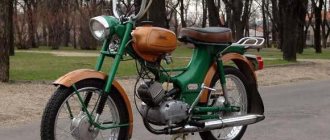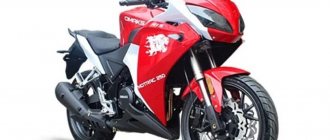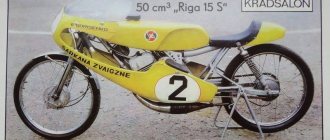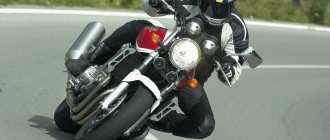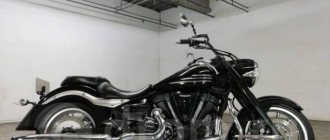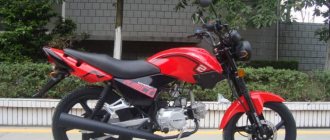Appearance and shock-absorbing qualities of Mokik ZiD 50
Mokik ZiD 50 in its front part differs little from its two-wheeled counterparts. At the rear, the frame is a frame for a spacious body, installed between the rear wheels. The seat is long and allows two people to sit comfortably. The engine is located under the seat. The gearbox, which allows you to move in reverse, is placed between the rear wheels.
Mokik ZiD 50 02 cargo is presented in the form of a three-wheeled vehicle with a body
Fenders above the rear and front wheels, mirrors on the steering wheel arches, a chrome fork, a large square headlight in the fairing, stylish turn signals - all this gives the moped a serious and expensive look. It compares favorably with its counterparts (cargo mopeds) in style and catchy appearance. The bright, red coloring of the body and body only emphasizes the shape and pleases the eye.
For comparison, one can recall the gray-green appearance of the old “Ant”, truly a workhorse that causes despondency.
ZID 50 “Pilot”
Was released in 1995. It was equipped with a fairly powerful two-stroke fifty-cc engine. The lightweight moped turned out to be very powerful, and could reach a speed of 50 kilometers per hour while consuming only 2 liters of fuel per hundred kilometers.
The three-speed gearbox was integrally connected to the engine. Four years later, a model with a raised front wing was released. And later the plant pleased us with the powerful ZiD-50-01 motorcycle, equipped with a Lifan engine; this model used a semi-automatic clutch.
Based on the ZID 50 “Pilot” model, the ZDK-2.404 cargo truck was later produced. It was three-wheeled and weighed only 112 kilograms. All technical specifications were the same as the previous model. Fuel consumption was 3 liters per hundred kilometers. The already well-known Lifan engine was installed on it. The model was complemented by a rear differential.
Since 2000, the plant has produced ZID 50-01 “Active”. There were no significant differences from previous models. A fairly powerful Chinese-made Lifan engine was used. The model was distinguished by a beautiful and stylish plastic body kit, similar to the trim of cruisers.
Specifications
The technical characteristics of the device include several indicators:
- Size and comfort. The length of the mokika with a body is 2350 cm, width is 1050 cm, height is 780 cm, the body does not create problems while driving. The driver's seat is soft and comfortable, the steering wheel grips are at a comfortable height. One more person can easily fit in the seat behind the driver.
A small engine volume allows you to operate the device without special rights - Engine and gearbox. Engine power 2.72 horsepower, cylinder volume 50 cm3. With these parameters, on a flat road with an average load, the speed of the mokik reaches 50 km/h. At the same time, the engine is quite economical, consuming only 2.2 liters per 100 km. The cooling system is air, using oncoming air flows when driving. The gearbox is manual, 3-speed. There is a reverse speed.
- Brakes. Drum-type, capable of abruptly stopping even a loaded trike.
- Suspension. The suspension has a set of shock absorbers, which makes driving even off-road soft and comfortable.
- Wheels. Light, inflatable, of the same diameter. This allows you to buy a set of tires and tubes at once, without remembering the difference in size between the front and rear wheels.
- Additional equipment. Additional equipment includes rear-view mirrors, turn signals and a powerful headlight, and there is also a signal.
Technical characteristics of the Zid 50 Pilot moped
- type - sports road motorcycle.
- engine - 1 cylinder, two-stroke (new models with LIFAN engine - four-stroke).
- maximum power - 2 kW = 2.72 hp.
- engine capacity - 50 cubic meters. see (49.00).
- 3-speed gearbox in the same unit with the engine.
- fuel system - carburetor.
- cooling system – air.
- drive - chain (standard drive sprocket - 14 teeth, driven sprocket - 42 teeth).
- front and rear drum brakes.
- starting system - kickstarter.
- seat height – 800 mm.
- wheelbase – 1300 mm.
- ground clearance - 150 mm.
- dry weight – 87 kg.
- type of gasoline - AI-92.
- gas tank volume – 6 liters.
- Fuel consumption is 2.2 liters per 100 km.
- maximum speed - 50 km/h.
Model range overview
The lineup consists of the following models:
Zid 50. The Mokik ZiD 50 carburetor creates a power of 2 horsepower. However, there are modifications that depend specifically on the number of revolutions and, accordingly, power.
The moped model range has several options
- ZiD 50-01 with carburetor Mokik ZiD 50 01.
- ZiD 50-02 with Mokik ZiD 50 02 carburetor.
- ZiD 50-02 with an engine power of 2.7 hp.
In general, the models are the same. The mass of each mokik is 112 kg, the load capacity is 100 kg. The speed does not decrease, remaining within 45-50 km/h.
ZiD-50-01, mokik. “Pilot” with a 4-stroke Chinese lifan engine.
Boris DAKHNOVSKY, photo by Alexey MELIKHOV
(Page 1) [1]
[2]
Year of manufacture 2004, Engine 49 cm3, Power 2.72 l. s., Weight 87 kg, Max. speed 50 km/h, Approximate price RUB 23,500.
Rumors that ZiD is about to start assembling the most popular domestic “fifty kopeck” with a 4-stroke Chinese engine have been circulating for a long time. Finally they materialized.
While the mechanic was preparing the mokick for the test, I studied the instruction manual. The description of the new motor is extremely concise: the pictures show only the location of the main components. Engine drawings are missing. Maybe they are not needed?..
The mechanic said: “The pilot is ready to fly.” - “Why didn’t you turn off the headlight - you’ll drain the battery!” - “No, the motor is running. I listened: indeed, it works, but how quietly! Even on a very quiet street you can hear the sound of the engine if you come close to the mokik.
The Chinese engine is equipped with a carburetor with a cable drive of the starting enrichment and its own gas tap - now the Pilot has two of them.
There are few changes in the design, with the exception of the new 4-stroke, but they will surprise not only the orthodox adherent of domestic motorcycle technology, but also other connoisseurs of foreign cars. The clutch lever has disappeared - it is centrifugal, with a semi-automatic device. A round window has appeared next to the speedometer; now the green letter N is glowing in it, and unlit numbers from one to four are visible next to it. You guessed it: when you turn on a particular gear, the corresponding number lights up, they are located in a circle. And not by chance. In this gearbox, shifting also occurs “in a circle”, that is, after the fourth - neutral, and then the first, etc. Or vice versa, if you change gears in the reverse order. By the way, from first to fourth, shifting occurs by pressing the lever under the left foot down, and not by lifting it up, as on most motorcycles. I really didn’t expect to find on a modern device an algorithm that was used on Czech motorcycles thirty years ago. However, the same principle has been in the gearbox of Honda Super Cub engines since the early 60s. It was not for nothing that I mentioned the Japanese engine, because it was one of its 50 cc versions, but in Chinese design, that was installed on the “Pilot”.
A lever appeared to the right of the speedometer, which controls the carburetor starting enrichment via a cable. And one more pleasant thing: a button appeared on the right switch box - a sign of the presence of an electric starter. I did not deny myself the pleasure: I turned off the engine, poked my finger at the button - the warmed-up engine instantly responded with a quiet rustle. I felt like a “white man”... The Mikuni carburetor, although, again, Chinese-made, knows its stuff.
The left hand automatically contracts to press the clutch lever... But it’s not there! “Stolen!” - the mechanic neighed... I remembered: the clutch here is centrifugal, like on scooters. He stuck it into first gear without touching the throttle, and the mokik tensed, but remained in place. I added gas and moved off smoothly. I accelerated a little and, fighting the habit of pulling the lever up, released the gas and switched to second. The lever is quite tight, because the clutch automatically disengages when you press the “push” button - almost like on Javas and Izh-Jupiters. You need to operate the lever moderately quickly - this is so that the crankshaft speed has time to decrease. Toropyga will receive a kick in the “fifth point” from the mokick even when switching to 4th.
New on the “Pilot” instrument panel: gear engaged indicator (on the left), drive handle for the carburetor starting enrichment (to the right of the speedometer).
I was warned: don’t “force” an untested engine, it will only really pull after 10 hours of driving. Indeed, it doesn’t work. The engine becomes sluggish at speeds above average. It’s okay, says the mechanic, at least drive five kilometers. Between the third and fourth kilometers the mokik began to transform, and by the sixth it was walking quite well. There was no point in measuring the maximum speed and acceleration dynamics before the end of the run-in. The engine pulls well at low end. Which is not surprising: a 4-stroke is supposed to be “more flexible” than a 2-stroke - even in the second “Pilot” it moves off easily. If, after intensive braking in third or fourth to a speed below 10 km/h, you add gas, the engine revs up slightly. This centrifugal clutch helps it slip into operating mode. Comfortable? Yes! But you should not abuse this help. If, relying on automatic transmission, you do not rush to switch gears to lower ones in a timely manner, you can quickly burn out the pads. To save the transmission, when starting off, always engage the gear at idle speed and only then “open” the gas. Automaticity acquired on other motorcycles can be harmful. I realized this by turning on second instead of fourth when accelerating a couple of times... Detail: there is no vibration at all that tires the driver.
(Page 1) [1] [2]
Source of material: MOTO magazine
ZID 50-05 or ZID Lifan 50
Later, the ZID 50-05 model was produced at the Degtyarov Plant. It was a licensed copy of the famous Lifan 50 scooter . The Russian model was similar to its Chinese counterpart. Its main advantages include:
- powerful four-stroke Lifan 1P39FMA engine;
- air cooling of the engine;
- weight not exceeding 82 kilograms;
- strong plastic casing that is not subject to mechanical stress and corrosion;
- large bright headlight;
- presence of a passenger seat;
- the presence of spacious trunks for storing things and equipment located under the driver’s seat and dashboard;
- presence of a glove compartment for documents and small items, locked with a key.
The features of the ZID 50-05, like the Chinese scooter Lifan 50 , usually include:
- a soft saddle that allows you not to get tired from a long journey;
- alloy wheels for wheels;
- easy to read dashboard;
- comfortable seat for the passenger;
- the presence of handles that the passenger can hold on to.
ZID 50-05 and Lifan
50 were famous for their:
- small size;
- ease of control;
- increased maneuverability;
- high level of security.
Lifan 50 scooter model and its Russian copy are suitable for beginner motorcyclists. Driving them does not require special knowledge, skills or training.
The Lifan 50 scooter is a high-quality and fashionable model of scooters that has reached a high level of popularity in the world. ZID 50-05 was also in demand because it was of high quality and quite cheap.
